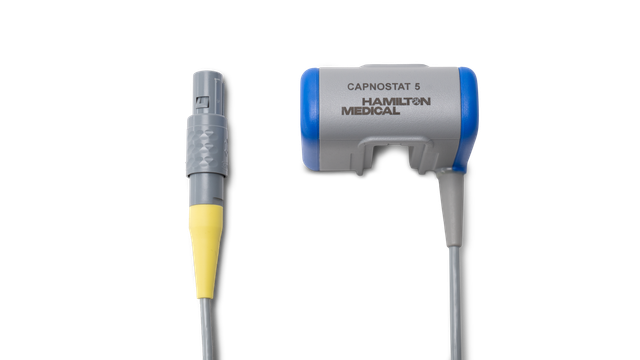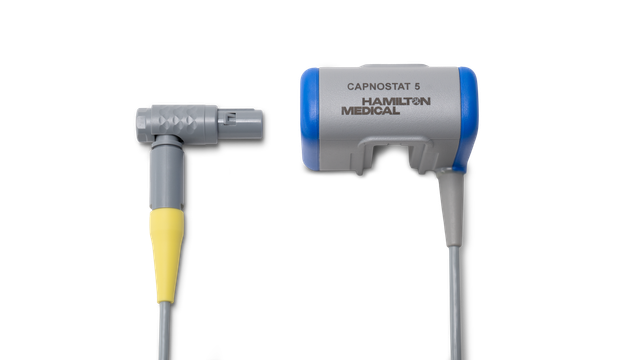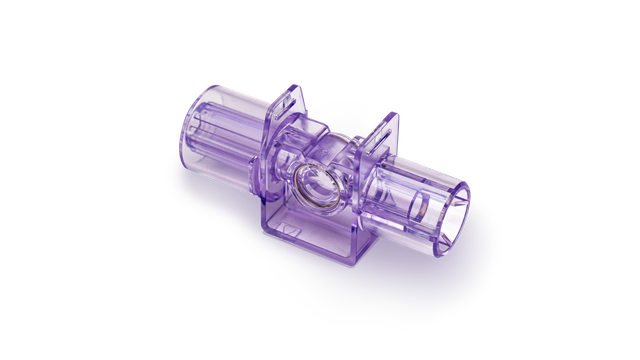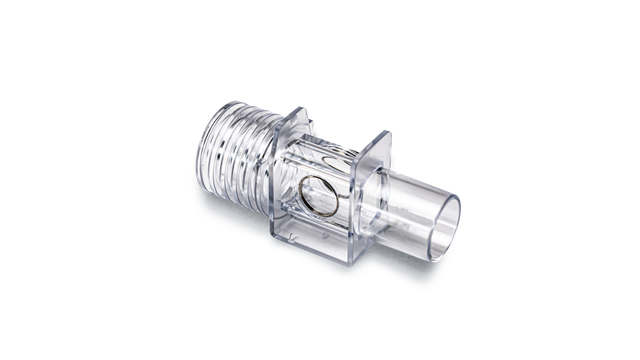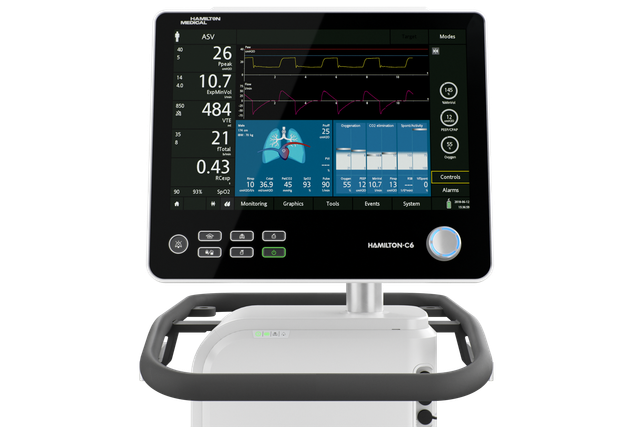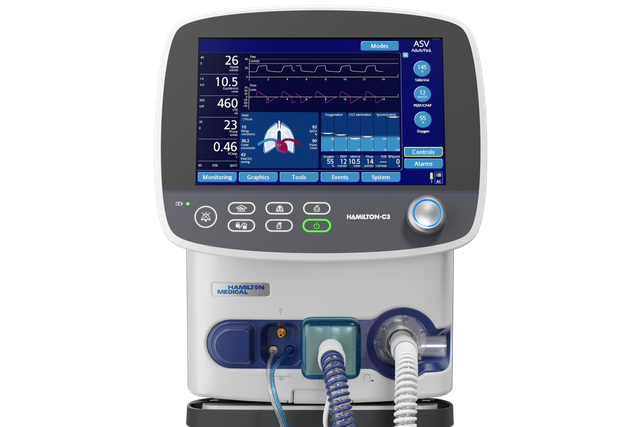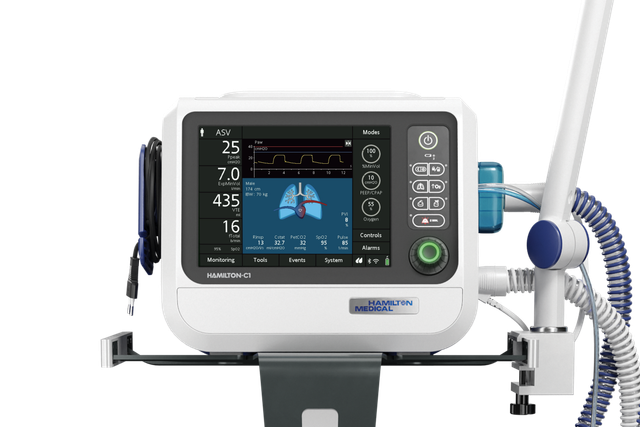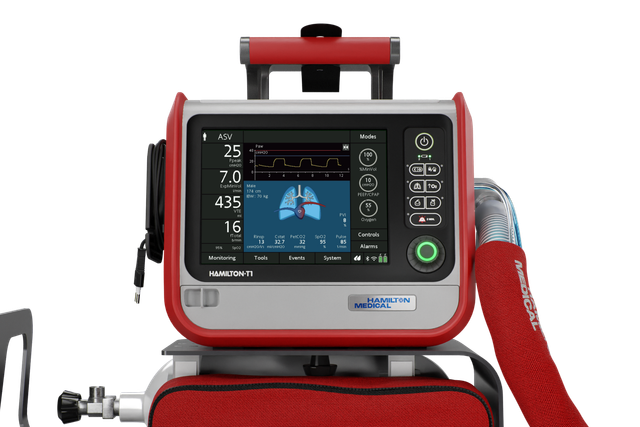
Für einen besseren Einblick. Volumetrisches CO2‑Monitoring
Die Phasen eines volumetrischen Kapnogramms, die Form und die Kurvenmorphologie sowie die Messungen, die auf den Berechnungen basieren, können Ihnen wichtige Informationen über Folgendes liefern:
- Ventilations‑Perfusions‑Effizienz
- Physiologische Totraumfraktion
- Metabolische Rate des Patienten (
Jaffe MB. Using the features of the time and volumetric capnogram for classification and prediction. J Clin Monit Comput. 2017;31(1):19‑41. doi:10.1007/s10877‑016‑9830‑z1 )
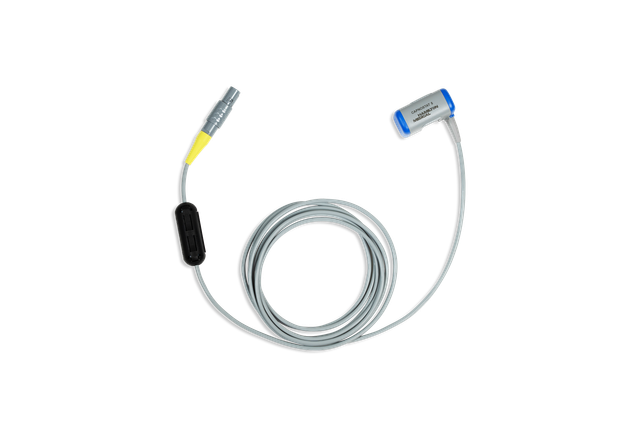
Ein mächtiges Tool. Der CO2‑Sensor
Bei unseren Beatmungsgeräten wird das CO2 mit einem CAPNOSTAT‑5 Hauptstrom‑CO2‑Sensor proximal zum Atemweg des Patienten gemessen.
Der CAPNOSTAT‑5 Sensor liefert präzise Messungen des endtidalen Kohlendioxids (PetCO2) und ein klares, genaues Kapnogramm bei allen Atemfrequenzen von bis zu 150 Atemzügen pro Minute.
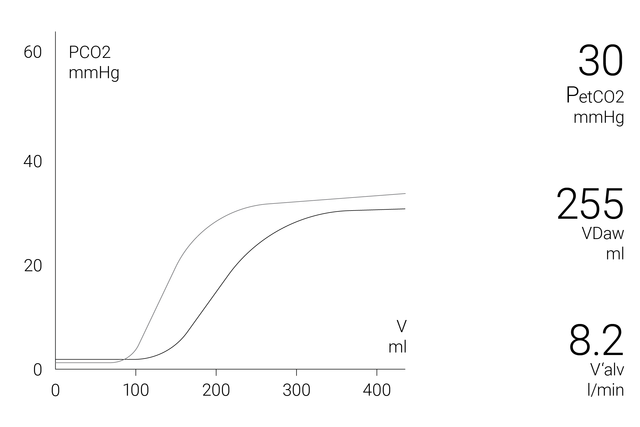
Kleiner Sensor, grosse Daten. Das Ergebnis kann sich sehen lassen
Das volumetrische Kapnogramm‑Fenster auf dem Bildschirm zeigt genaue quantitative Informationen als Kombination von proximalen Flow‑ und proximalen CO2‑Daten an, wie z. B.:
- Aktuelle volumetrische Kapnogramm‑Kurve
- Volumetrische Kapnogramm‑Referenzkurve
- Referenzkurven‑Taste mit Zeit und Datum des Referenz‑Loops
- Die wichtigsten CO2‑Werte, Atemzug für Atemzug
Um eine umfassendere Analyse des Patientenzustands zu ermöglichen, steht ein 72‑Stunden‑Trend (bzw. ein 96‑Stunden‑Trend beim HAMILTON‑G5/S1) für folgende Werte zur Verfügung:
- PetCO2
- V‘CO2
- FetCO2
- VeCO2
- ViCO2
- VTalv
- VTalv/min
- Vds
- Vds/Vt
- Vds/VTE
- SlopeCO2
Um Ihnen das Leben zu erleichtern, bieten die Beatmungsgeräte von Hamilton Medical im CO2‑Monitoring‑Fenster einen Überblick über alle relevanten CO2‑bezogenen Werte.
- Fraktionale, endtidale CO2‑Konzentration: FetCO2 (%)
- Endtidaler CO2‑Druck: PetCO2 (mmHg)
- Anstieg des alveolaren Plateaus in der PetCO2‑Kurve, der den Volumen‑/Flow‑Status der Lunge anzeigt: SlopeCO2 (%CO2/l)
- Alveolare Tidalbeatmung: VTalv (ml)
- Alveolares Minutenvolumen: VTalv/min (l/min)
- CO2‑Eliminierung: V’CO2 (ml/min)
- Atemwegstotraum: Vds (ml)
- Atemwegs‑Totraumfraktion an der Atemwegsöffnung: Vds/VTE (%)
- Exspiriertes CO2‑Volumen: VeCO2 (ml)
- Inspiriertes CO2‑Volumen: ViCO2 (ml)
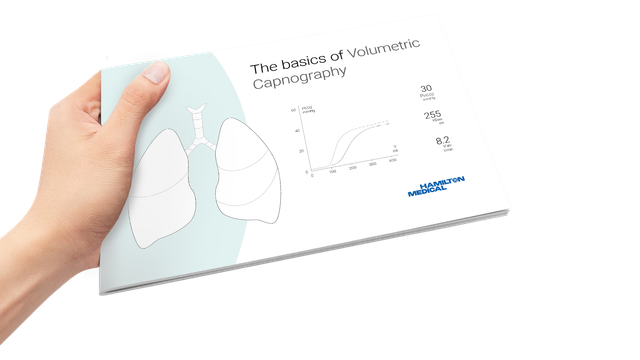
Kostenloses eBook
Gut zu wissen! Alles über die volumetrische Kapnographie
Das eBook erklärt, wie ein volumetrisches Kapnogramm interpretiert wird, und stellt einen Überblick über die Vorteile und klinische Anwendung der volumetrischen Kapnographie zur Verfügung. Selbsttest inkludiert!
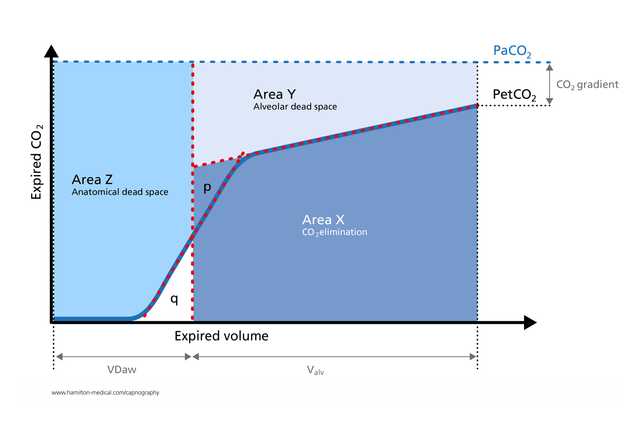
Was spricht dafür? Klinische Nachweise im Überblick
Das volumetrische Kapnogramm wurde erfolgreich für die Messung des anatomischen Totraums, der pulmonalen Kapillardurchblutung und der Beatmungseffizienz eingesetzt (
Romero PV, Lucangelo U, Lopez Aguilar J, Fernandez R, Blanch L. Physiologically based indices of volumetric capnography in patients receiving mechanical ventilation. Eur Respir J. 1997;10(6):1309‑1315. doi:10.1183/09031936.97.100613092 ).Die aus der volumetrischen Kapnographie abgeleiteten Berechnungen sind nützlich, um eine Lungenembolie am Patientenbett zu erkennen (
Blanch L, Romero PV, Lucangelo U. Volumetric capnography in the mechanically ventilated patient. Minerva Anestesiol. 2006;72(6):577‑585. 3 ).In einer Studie an maschinell beatmeten ARDS‑Patienten waren volumetrische Kapnographie‑Messungen des Verhältnisses von physiologischem Totraum zu Tidalvolumen ebenso genau wie die Werte, die mit der Überwachung der metabolischen Rate ermittelt wurden (
Kallet RH, Daniel BM, Garcia O, Matthay MA. Accuracy of physiologic dead space measurements in patients with acute respiratory distress syndrome using volumetric capnography: comparison with the metabolic monitor method. Respir Care. 2005;50(4):462-467. 4 ).Das exspiratorische Kapnogramm ist eine anstrengungsunabhängige, schnelle und nichtinvasive Messung, die bei erwachsenen Asthmapatienten die Erkennung signifikanter Bronchospasmen unterstützen kann (
Yaron M, Padyk P, Hutsinpiller M, Cairns CB. Utility of the expiratory capnogram in the assessment of bronchospasm. Ann Emerg Med. 1996;28(4):403‑407. doi:10.1016/s0196‑0644(96)70005‑75 ).Die volumetrische Kapnographie bietet auf nichtinvasive Weise in Echtzeit wertvolle Einblicke in die Physiologie des Lungenkollapses und des Recruitments und eignet sich daher zur Überwachung zyklischer Recruitmentmanöver am Patientenbett (
Tusman G, Suarez‑Sipmann F, Böhm SH, et al. Monitoring dead space during recruitment and PEEP titration in an experimental model. Intensive Care Med. 2006;32(11):1863‑1871. doi:10.1007/s00134‑006‑0371‑76 ).

Gut zu wissen! Schulungsressourcen für die volumetrische Kapnographie
Zubehör und Verbrauchsmaterialien
Wir bieten Originalverbrauchsmaterialien für Erwachsene, Pädiatrie und Neonaten. Je nach den Richtlinien in Ihrer Einrichtung haben Sie die Wahl zwischen wiederverwendbaren Produkten und Ausführungen für den Einmalgebrauch.
Verfügbarkeit
Die volumetrische Kapnographie ist auf den Beatmungsgeräten HAMILTON‑C6, HAMILTON‑G5, HAMILTON‑C3, HAMILTON‑C1/T1 als Option verfügbar und gehört auf dem HAMILTON‑S1 zu den Standardfunktionen.
Referenzen
- 1. Jaffe MB. Using the features of the time and volumetric capnogram for classification and prediction. J Clin Monit Comput. 2017;31(1):19‑41. doi:10.1007/s10877‑016‑9830‑z
- 2. Romero PV, Lucangelo U, Lopez Aguilar J, Fernandez R, Blanch L. Physiologically based indices of volumetric capnography in patients receiving mechanical ventilation. Eur Respir J. 1997;10(6):1309‑1315. doi:10.1183/09031936.97.10061309
- 3. Blanch L, Romero PV, Lucangelo U. Volumetric capnography in the mechanically ventilated patient. Minerva Anestesiol. 2006;72(6):577‑585.
- 4. Kallet RH, Daniel BM, Garcia O, Matthay MA. Accuracy of physiologic dead space measurements in patients with acute respiratory distress syndrome using volumetric capnography: comparison with the metabolic monitor method. Respir Care. 2005;50(4):462‑467.
- 5. Yaron M, Padyk P, Hutsinpiller M, Cairns CB. Utility of the expiratory capnogram in the assessment of bronchospasm. Ann Emerg Med. 1996;28(4):403‑407. doi:10.1016/s0196‑0644(96)70005‑7
- 6. Tusman G, Suarez‑Sipmann F, Böhm SH, et al. Monitoring dead space during recruitment and PEEP titration in an experimental model. Intensive Care Med. 2006;32(11):1863‑1871. doi:10.1007/s00134‑006‑0371‑7


